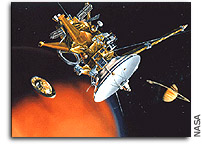Cassini Significant Events for 04/24/03 – 04/30/03

The most recent spacecraft telemetry was acquired from the Canberra
tracking station on Wednesday, April 30. The Cassini spacecraft is in an
excellent state of health and is operating normally. Information on the
present position and speed of the Cassini spacecraft may be found on the
“Present Position” web page located at
http://saturn.jpl.nasa.gov/operations/present-position.cfm .
April 26th marked the 5th anniversary of Cassini’s first Venus flyby.
Cassini is using a Venus-Venus-Earth- Jupiter trajectory. Each flyby
provides a gravity assist that cumulatively will enable Cassini to reach
Saturn in 2004.
The Command and Data Subsystem (CDS) Flight Software (FSW) checkout
concluded this week with a successful optical navigation (OPNAV) test.
Final activities for C36 included a reaction wheel assembly momentum
unload, and uplink of the C37 background sequence.
The completion of the optical navigation test marks the conclusion of
the engineering flight software checkout period. Both the Attitude
Control and Command and Data subsystems have successfully demonstrated
the full suite of capabilities afforded by the new software that will be
used throughout orbital operations.
C37 began execution late Monday night. Initial activities included
loading of Imaging Science Subsystem (ISS), Ultraviolet Imaging
Spectrograph (UVIS), and Radio and Plasma Wave Science (RPWS) instrument
expanded blocks from the background sequence, RPWS high-rate
observations, an RPWS high frequency receiver calibration, and clearing
of the attitude control high water marks. At the end of this week the
spacecraft transitioned to reaction wheels in preparation for trajectory
correction maneuver 19.
Optical navigation data from this weeks test have been processed by the
Multimission Image Processing Laboratory (MIPL), including 18 Narrow
Angle Camera (NAC) and nine Wide Angle Camera (WAC) images. The
Navigation team has reviewed the data and reported that pointing was
very good (within about five or six NAC pixels of the target) and that
the exposures on 11th magnitude stars are good.
Mission Planning and Science Planning held a kick off meeting for the
implementation of the science operations plan for tour sequences tour
sequences S7/S8 this week, along with a project briefing for the cruise
sequence C39.
An Archive Design Peer Review of the Cosmic Dust Analyzer (CDA), ISS,
Radio Science Subsystem (RSS), and Visual and Infrared Mapping
Spectrometer (VIMS) instrument team archive plans was held this week.
Members of the Planetary Data System, instrument team representatives,
and Instrument Operations personnel attended.
A Software Review Certification Requirement meeting was held for
Composite Infrared Spectrometer FSW version 2.0.1. The software is due
to be uplinked to the spacecraft in late May.
MIPL delivered an engineering version of the remote constraint checker
tools to the ISS and VIMS science teams. The software will be used for
validation of Instrument Operations Interface (IOI) files prior to
delivery to IO. These tools allow a remote site to automatically
deliver preliminary IOI files to MIPL, have them error/constraint
checked there, and have the results returned to the remote site. During
operations this will enable instrument teams to deliver error-free IOI
files.
Cassini is a cooperative project of NASA, the European Space Agency and
the Italian Space Agency. The Jet Propulsion Laboratory, a division of
the California Institute of Technology in Pasadena, Calif., manages the
Cassini mission for NASA’s Office of Space Science, Washington, D.C.








